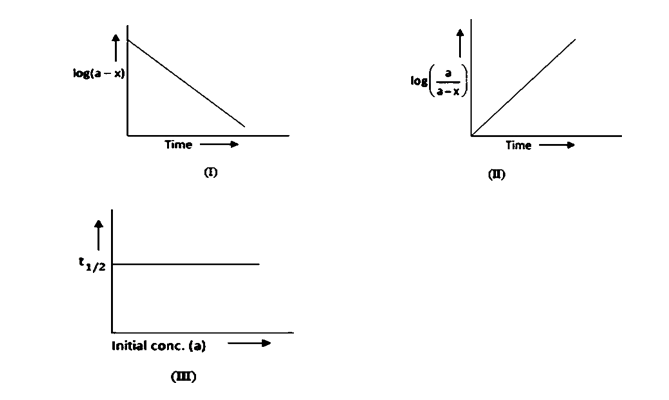Which of the following reaction (s) is / are of the first order ?
The decompoistion of ammonium nitrate in an aqueous solution.
The inverison of cane sugar in the presence of an acid.
The acidic hydrolyiss of ethyl acetate.
All radioactive decays.
The correct Answer is:A, B, C, D
To determine which of the given reactions are of the first order, we need to understand the characteristics of first-order reactions. A first-order reaction is defined as one where the rate of reaction depends on the concentration of one reactant raised to the power of one.
Let's analyze the reactions one by one:
1. Decomposition of Ammonium Nitrate (NH4NO3):
- The reaction can be represented as:
NH4NO3→N2O+2H2O
- In this reaction, the rate depends on the concentration of ammonium nitrate. Since it depends on one reactant and the power is one, this is a first-order reaction.
2. Inversion of Cane Sugar (C12H22O11):
- The reaction can be represented as:
C12H22O11+H2O→C6H12O6+C6H12O6
- In this case, the reaction occurs in the presence of an acid, and water is in excess. Therefore, the rate depends primarily on the concentration of sucrose. This makes it a first-order reaction as well.
3. Hydrolysis of Ethyl Acetate (CH3COOCH2CH3):
- The reaction can be represented as:
CH3COOCH2CH3+H2O→CH3COOH+CH3OH
- Similar to the previous reactions, water is in excess, and the rate depends on the concentration of ethyl acetate. Hence, this is also a first-order reaction.
4. Radioactive Decay:
- Radioactive decay can be represented as:
N→N−decay products
- All radioactive decay processes are inherently first-order reactions, as the rate of decay is proportional to the number of undecayed nuclei present.
Based on the analysis above, all the reactions listed (A, B, C, and D) are first-order reactions.
Final Answer:
All of the reactions (A, B, C, and D) are of the first order.
- The reaction can be represented as:
NH4NO3→N2O+2H2O
- In this reaction, the rate depends on the concentration of ammonium nitrate. Since it depends on one reactant and the power is one, this is a first-order reaction.
- The reaction can be represented as:
C12H22O11+H2O→C6H12O6+C6H12O6
- In this case, the reaction occurs in the presence of an acid, and water is in excess. Therefore, the rate depends primarily on the concentration of sucrose. This makes it a first-order reaction as well.
- The reaction can be represented as:
CH3COOCH2CH3+H2O→CH3COOH+CH3OH
- Similar to the previous reactions, water is in excess, and the rate depends on the concentration of ethyl acetate. Hence, this is also a first-order reaction.
- Radioactive decay can be represented as:
N→N−decay products
- All radioactive decay processes are inherently first-order reactions, as the rate of decay is proportional to the number of undecayed nuclei present.
All of the reactions (A, B, C, and D) are of the first order.
Topper's Solved these Questions
- CHEMICAL KINETICSBOOK - CENGAGE CHEMISTRY ENGLISHCHAPTER - CHEMICAL KINETICSEXERCISE - Exercises Single Correct
177 Videos
- CHEMICAL KINETICSBOOK - CENGAGE CHEMISTRY ENGLISHCHAPTER - CHEMICAL KINETICSEXERCISE - Exercises Assertion-Reasoning
22 Videos
- CHEMICAL KINETICSBOOK - CENGAGE CHEMISTRY ENGLISHCHAPTER - CHEMICAL KINETICSEXERCISE - Exercises Linked Comprehension
59 Videos
- CARBOXYLIC ACIDS AND THEIR DERIVATIVESBOOK - CENGAGE CHEMISTRY ENGLISHCHAPTER - CARBOXYLIC ACIDS AND THEIR DERIVATIVESEXERCISE - Exercises Archives (Analytical And Descriptive)
34 Videos
- COORDINATION COMPOUNDSBOOK - CENGAGE CHEMISTRY ENGLISHCHAPTER - COORDINATION COMPOUNDSEXERCISE - Archives Subjective
18 Videos
Similar Questions
Which of the following isomerization reactions is/are of the first order?
View SolutionWhich of the following reaction is not of the first order ?
View SolutionWhich of the following expression is correct for first order reaction? Ao refers to initial concentration of reactant
View SolutionWhich of the following is/are correct for the first order reaction ? (a is initial concentration of reactant, x is concentration of the reactant reacted and t is time)

View SolutionWhich of the following is/are correct about the first order reaction ?
View SolutionWhich of the following is/are correct for the first order reaction?

View SolutionWhich among the following reactions is can be a example of pseudo first order reaction?
View SolutionWhich of the following expresison is correct for first order reaction (c0 refers to initial concentration of reactant)
View SolutionWhich of the following graph is correct for a first order reaction ?
View SolutionWhich of the following is (are) not correct for a first order reaction?
View Solution
